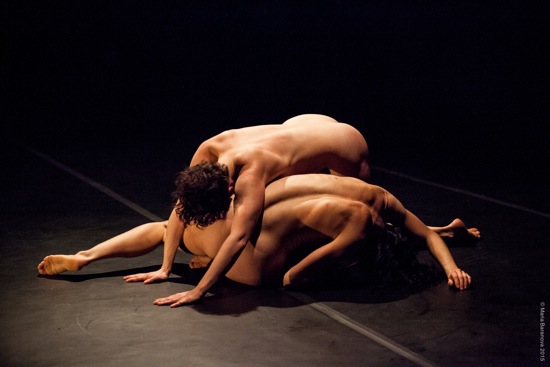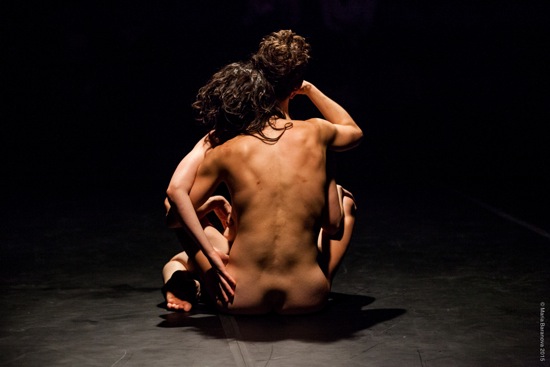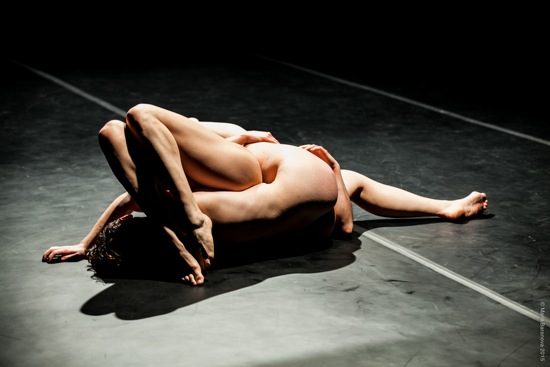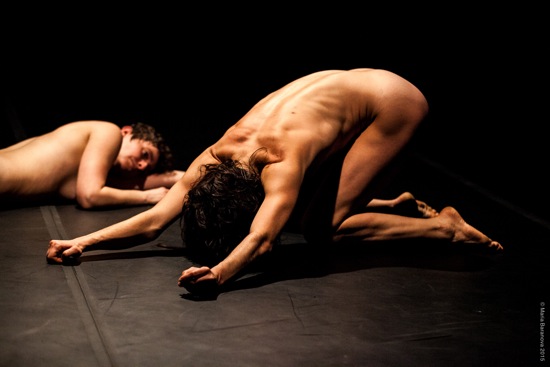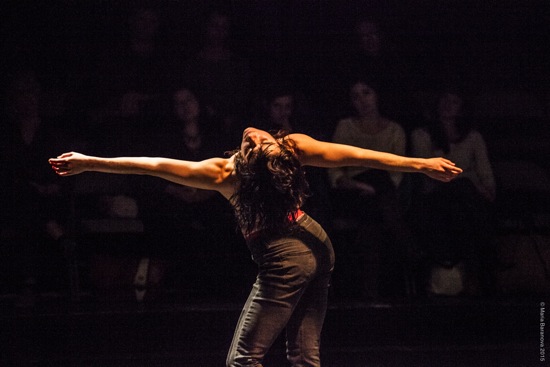My introduction to the work of Molly Lieber and Eleanor Smith was a more intimate one than I would have expected. I had missed—my loss—their Beautiful Bone (2012) and Tulip (2013) and trekked to the Chocolate Factory to see the Rude World, with my eyes and mind wide open and my ears pricked.
For the third part of this triptych (a co-commission and co-presentation of the Chocolate Factory and Performance Space 122 as part of the Coil Festival), the narrow space has been muted. Black drapes cover the two long walls, and the floor too is black. Madeline Best’s lighting is clear and subtle—tiny white spotlights sit along one wall on the floor; larger ones hang opposite them and overhead. Some of the overheads shine down on the two banks of spectators as we wait for the performance to begin. The effect is eerie. I sit in one of three banked rows at one end of the space, staring at those in the three rows across the empty performing area. The lights are not intense, and the nearly motionless watchers I am watching look like background figures in a 19th-century painting or puppets who might at any moment come to life. This may be how they see us. Or not.
The lights go out; footsteps sound in the expectant darkness. The lights come on. Lieber, naked, is standing on the folding chair beside me at one end of a row of spectators. Smith, also naked, is standing above her on the chair, feet planted on either side of her thighs. Both face toward the other bank of spectators, although those people see little of Lieber —maybe only her arms and hands.
I am in the intimacy seat. At close range I watch Lieber reach up Smith’s back and gently, firmly stroke down both sides of her colleague’s spine. Her hands spread slightly to move over Smith’s hips and down her legs to her feet; five fingers spread to cover five toes. Smith doesn’t move; Lieber, her head an inch or so from Smith’s buttocks, looks up only when she needs to begin the act again. My eyes follow the arm closest to me, as it traces torso, haunches, legs, foot—moving with the rhythm of a slow, smooth intake of breath and its exhalation. I lose track of how many times this path is followed.
Lieber and Smith have described their vision for this work as two bodies trying to become one. Which also involves two sensibilities merging. Rude World doesn’t seem erotic to me, although it could strike some people that way, I suppose. Much of what the two do is improvised within a structure. Both, for instance, perform solos at different times. You can see that they are trained dancers (one of them, say, may circle a stretched leg around into what could be considered a casual acquaintance of an arabesque), but they emphasize a kind of awkwardness, an unguardedness that is accentuated by their lack of clothing.
While Smith is dancing, Lieber presses herself against one of the black walls and gradually sinks down toward the floor, bending her knees, adjusting her feet. She’s completely preoccupied with this, and when Smith joins her, you can watch them sensing how they might synchronize or differ in their timing. By the end, they’re beginning to intersect—one crawling, for instance between the other and the wall.
Smith dons a thong (for support) when she upends Lieber and carries her in various ways from one end of the space to the other, showing her to us. Each time Smith picks up her partner, it gets a little harder for her to walk with her burden.
The central part of the duet intensifies the notion of two merging into one. I think of Rodin’s small sculptures, in which figures melt into each other as they emerge from a common unworked mass. Lieber and Smith roll and turn together on the floor, their rosy flesh beautiful in the light. From their smooth, unhurried tangling, shifting, three-dimensional structures emerge. Now your eye fastens on a ribcage; the bones emerge as the torso stretches and then disappear under the cushioning flesh. Now you see the roundness of buttocks juxtaposed to an angled arm wrapping around a body belonging to someone else. The women, always nestling close and staying in contact, keep their faces mostly hidden.
Occasionally, by tacit consent, they rest a few seconds, before continuing their arduous journey. Whether by design or accident, at some point, the shapes they make elongate, become less egg-like in outline. At what I think of as the end of this section, both lie supine, one on top of the other. In the absence of any musical accompaniment, we’re aware of their breathing; we notice their bodie beginning to glisten with sweat.
At one point, the two women separate, and Lieber on her knees, stretches her spine over and over like a cat. She runs—stiff-legged and hunched over— then jumps. Over and over. She puts on striped jockey shorts, then jeans, and dances on. Smith adds garments too. Interesting! When they move in contact with each other clothed, what they do subtly suggests snapshots from a relationship. Does the addition of clothes promote this, or only help to do so by sparking our memories of two-person behavior?
The last, intricate picture the two offer us is that of a two-person sphinx. From my side’s viewpoint, Smith’s head and upper body emerge from a symmetrical surround of legs and buttocks—clearly not hers. But yes, hers. As she is their unwavering gaze.

